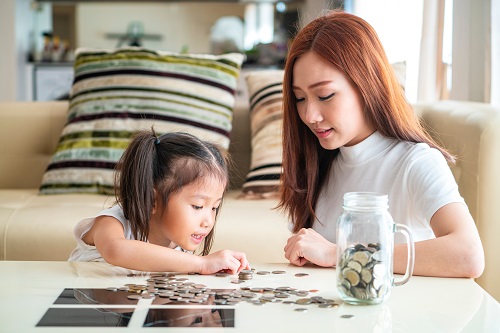Teaching Kids About Money
It’s safe to say that money and finances make up a huge part of our lives and are incredibly important.1 This includes budgeting to ensure bills are paid on time and financial goals are met, understanding, and maintaining your credit history, and building a savings to both prepare for potential emergencies and meet long-term financial goals. If you’re a parent or guardian, you want to help set your children up for success so, when they become adults, they have a good understanding of finances and can navigate through financial situations that come their way. While many financial topics can be confusing even for adults, a great starting point toward teaching your kids about finances is to first teach them the basics of money. Here are some easy ways you can teach your kids about money and start the foundation for their financial success.
Start With Basics
As you begin teaching your kids about money it’s best to keep it simple and start with the absolute basics. This entails teaching your kids the differences between coins and dollars, the names for each, and what money is used for. This level of education is better to start at a younger age, which allows them to start early and build a good foundation of knowledge before moving on to the next level. Younger children may have trouble concentrating when trying to learn, so it may be best to work your teachings into a game so it’s fun for them. For example, you could play a sorting game and have your kids match up coins and bills, which would help them learn the differences between the monies.
Counting Money
Once your children have mastered the basics of money you can move on to the next step which is learning how to count money. This includes adding up different currencies, plus learning how to make change as well. Since this level of education requires your kids to have a good understanding of addition and subtraction it’s probably best for kids who are slightly older. Once again, if you have trouble getting your kids to concentrate on learning you can make the lesson more fun by playing a game. For example, you could get a toy cash register and pretend you’re shopping at the grocery store or someplace similar. Many toy cash registers come with their own play money, but to really drive home your lesson and help your kids get used to handling money, you could choose to use real money during your game.
Earning Money
At this point, your kids should have a good understanding of how money works, and now you can kick it up a notch and teach them how to earn money to pay for the things they want. This should also help them learn the value of money.2 There are multiple ways you can do this. One way is to give your kids an allowance for completing certain chores. You could create a list of chores they need to complete each day, or throughout the week, and give them a set allowance each week for completing those chores. Once your kids have earned their money, they can do with it whatever they choose. Another way to approach this is to have your kids declare something specific they’d like to use their money on. This could be a certain toy they’d like to buy, or something they’d like to do such as a trip to the movies. The first scenario will give your kids more freedom in spending their earned money, while the second one will be more direct in teaching them how far a dollar can go and the importance of saving. However, no matter which option you choose your kids will be able to learn the value in earning money and how to use it for the things they want.
Paying Bills
As your kids get older and into their teen years, a great way to teach them some financial responsibility would be to have them pay a bill. They could either use the money they earn in their allowance, or money they earn from a part-time job if they have one. Of course, they are still kids so you may want to choose a relatively minor bill they can easily manage. This could be a portion of the cell phone bill, or a portion of the car insurance bill if they drive. Giving your kids a small bill to be in charge of can teach them to plan ahead and be responsible with their money, preparing them for when they’re on their own and have many bills to manage. If you’re able to, you can further set your kids up for success by setting aside the money they pay for the bill you’ve assigned them in a savings account. Then, when they eventually move out to live on their own, you can give the money back to them to help them as they start their lives out of the nest.
Sources:
1Kenton, Will. (2022, Sept 16). Retrieved from: https://www.investopedia.com/terms/p/personalfinance.asp
2Lake, Rebecca. (2022, May 17). Retrieved from: https://www.investopedia.com/guide-allowances-and-kids-5217591

 You must have JavaScript enabled to use this site.
You must have JavaScript enabled to use this site.
 For a better user experience consider upgrading your browser.
For a better user experience consider upgrading your browser.

